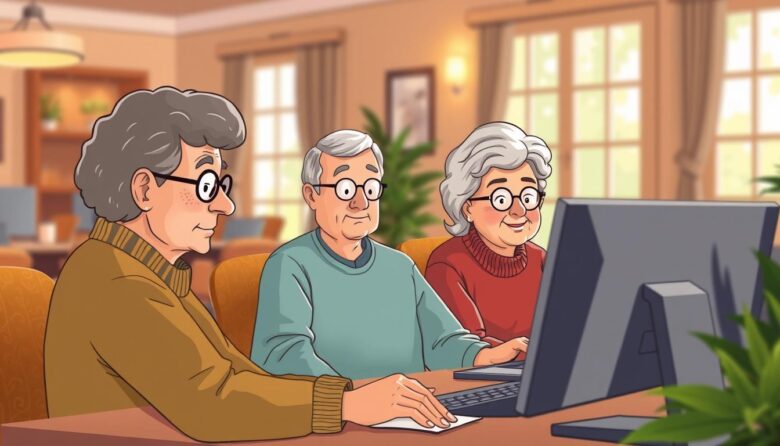Staying connected in today’s digital landscape doesn’t have to feel overwhelming. With over 333 billion messages exchanged globally every day, online communication has become a cornerstone of modern life. For older adults, learning to navigate this tool can open doors to meaningful interactions and reduce feelings of distance from loved ones.
You might wonder how technology fits into your routine. The truth is, digital messaging bridges the gap between traditional letters and instant updates. It’s a simple, reliable method to share photos, receive news, or join virtual gatherings—all from the comfort of your home.
Many hesitate to explore new tools, but this platform is designed for ease. Think of it as a digital mailbox that works at your pace. Whether you’re catching up with grandchildren or accessing community updates, it adapts to your needs without demanding constant attention.
Key Takeaways
- Over 333 billion digital messages are sent daily, making it a vital tool for global connection.
- Older adults can maintain relationships and reduce isolation through accessible online communication.
- This method blends familiarity with modern convenience, easing the transition to digital platforms.
- Common concerns about complexity are addressed through intuitive design and step-by-step guidance.
- Mastering this skill unlocks access to news, hobbies, and services tailored to your interests.
Understanding Email: A Beginner’s Guide for Seniors
Navigating modern communication tools can feel like learning a new language, but it’s simpler than you think. Imagine having a virtual post office that delivers letters in seconds instead of days. This system lets you exchange written notes, family photos, and important updates with anyone worldwide.
What Makes This Tool Essential?
Unlike paper mail, digital messages arrive instantly through the internet. You can share vacation pictures with grandchildren or review medical updates from trusted sources. Many organizations, like the National Institute on Aging, send twice-monthly wellness tips directly to your inbox—no waiting required.
More Than Just Messages
Staying informed becomes effortless with subscriptions to topics you care about. Local community groups often share event details this way, letting you participate in neighborhood projects or charity drives. It’s also a practical method to voice opinions to government representatives—every signed petition matters.
Learning this skill keeps your mind sharp. Figuring out how to organize your inbox or attach files becomes a rewarding mental exercise. Plus, you’ll discover new recipes, hobby ideas, and travel inspiration through curated content tailored to your interests.
Email Basics for Seniors: Setting Up Your Account
Getting started with digital communication begins with a reliable account. Four main providers dominate the market, each offering unique benefits. Let’s explore which service aligns best with your lifestyle and devices.
Top Providers Compared
Google’s Gmail leads with 1.5 billion users worldwide. Its voice-typing feature helps those who prefer speaking over typing. Apple enthusiasts will appreciate iCloud Mail’s seamless sync between iPhones and iPads.
Microsoft loyalists find Outlook ideal for managing medical appointments through calendar integrations. Yahoo stands out for storing family photos without cluttering your main inbox.
Building Your Account
Visit your chosen provider’s website and click “Create Account.” You’ll enter basic details like your name and phone number for security. Pick an address that’s easy to remember—many combine initials with birth years.
Create a password mixing uppercase letters, symbols, and numbers. Think “Grandkid2024!” instead of “password123.” Most services guide you through each step, offering tips for stronger security.
Once set up, you’ll gain instant access to message loved ones, receive event reminders, and share life updates. Many platforms provide tutorials if you need extra help navigating features.
Navigating Your Inbox with Ease
Mastering your inbox feels like finding order in a bustling room. Start by focusing on three core features: composing messages, managing replies, and storing important details. Clear communication begins with thoughtful structure—both in what you send and how you organize what you receive.
Crafting Clear Communications
When writing a message, begin with the recipient’s address—double-check for typos. Use specific subject lines like “Re: Book Club Date” to highlight your purpose. Keep paragraphs short and focused, just like writing a friendly note.
The “CC” field lets others stay informed without needing to reply. For sensitive topics, “BCC” protects privacy by hiding addresses. Need to share photos? Click the paperclip icon to add attachments before sending.
Smart Sorting Strategies
Create folders named “Family Updates” or “Medical Info” to group similar messages. Labels act like color-coded sticky notes for quick scanning. Set aside 5 minutes daily to sort new arrivals—this habit keeps your inbox from becoming overwhelming.
Always preview your message before hitting send. Check for clear phrasing and proper punctuation. With practice, these steps become second nature, letting you focus on meaningful connections rather than technical details.
Staying Safe Online: Protecting Your Email and Personal Information
Online safety starts with recognizing potential threats before they knock. Cybercriminals often target older adults, assuming they’re less familiar with digital risks. In 2024 alone, identity theft cost Americans $43 billion—a stark reminder to guard your details carefully.
Spotting Suspicious Messages
Phishing attempts often mimic trusted sources like banks or delivery services. Watch for urgent requests to update accounts or confirm payments. Check sender addresses closely—scammers use odd combinations like “service@fedex7281.net” instead of official domains.
Never click unexpected links or attachments, even if they appear legitimate. Grammatical errors and mismatched logos are common red flags. When in doubt, contact the organization directly using their official website or phone number.
Building Digital Armor
Create passwords mixing letters, numbers, and symbols. “Sunset@Beach2024!” proves stronger than predictable phrases. Enable two-step verification through your account settings—this adds an extra layer of protection against unauthorized access.
Review privacy settings monthly to limit data sharing. Avoid posting sensitive details like Social Security numbers in messages. Most platforms offer spam filters—activate these tools to automatically block suspicious content.
By staying alert and using built-in security features, you’ll keep your private life exactly that—private. Every cautious step builds confidence in navigating the digital world safely.
Enhancing Your Email Experience
Personalizing your digital communication tools can transform routine tasks into enjoyable interactions. Modern platforms offer adaptable features that cater to individual preferences, making every message feel tailored to your needs.
Customizing Settings for Better Usability
Adjust text size and color schemes in your account settings for comfortable reading. Many services let you choose high-contrast themes or enlarge fonts with a single click. These changes apply across devices, ensuring consistency whether you’re on a tablet or computer.
Explore voice-typing tools if keyboard use feels challenging. Simply click the microphone icon in Gmail to dictate messages naturally. The snooze function temporarily hides less urgent notes, resurfacing them at your chosen time—perfect for managing priorities.
Activate spam filters to automatically divert suspicious messages. Most providers analyze content and sender reputations to block unwanted content. Paid subscriptions offer expanded storage for photos and documents, plus direct access to customer support teams.
Clear communication starts with thoughtful habits. Always include polite greetings like “Hello Mary” and close with your name. Proofread messages for clarity, and double-check attachments before sending. These small adjustments create professional, meaningful exchanges.
Accessing Email on Multiple Devices
Your messages travel with you wherever you go. Modern technology lets you stay connected through smartphones, tablets, and computers using one unified system. This flexibility means you can read updates at the park or send photos from your kitchen table.
Smartphone and Tablet Solutions
Devices like the Jitterbug Smart4 simplify mobile access with large buttons and clear menus. Free webmail services sync across all gadgets—start writing on your computer and finish on your phone during a coffee break. Account synchronization ensures every device shows the same messages automatically.
Setting up takes minutes. Download your provider’s app, enter your address and password, then tap “Sign In.” Senior-friendly interfaces minimize clutter while emphasizing essential features like composing messages or checking new arrivals.
Computer and Cross-Platform Access
Web browsers let you log in from any computer with internet. Bookmark your account page for quick access at libraries or community centers. Unlike provider-specific addresses, webmail keeps your contact details consistent if you switch internet services or relocate.
Public computers require extra caution. Always log out completely after sessions and avoid saving passwords. For home use, consider voice commands to navigate your inbox hands-free—ideal when typing feels challenging.
This multi-device approach adapts to your lifestyle. Whether sharing vacation stories from a tablet or reviewing medical updates on a desktop, your communications remain organized and accessible.
Wrapping It Up: Your Journey to Confident Email Communication
Mastering digital messages opens doors to meaningful connections in today’s world. You’ve learned to handle essential tasks—confirming medical visits or sharing family updates—with confidence. This skill maintains independence while keeping loved ones close.
Regular practice sharpens abilities. Try organizing messages using clear subject lines or exploring newsletters that spark joy. Each achievement reinforces growing expertise.
Support networks stand ready. Local classes designed for seniors provide guided learning, while family members enjoy teaching moments. Every email sent strengthens bonds and empowerment.
Continue exploring features comfortably. Whether reviewing bills or sending letters, you’re actively participating in society. Your progress enriches daily life and nurtures lasting relationships.



